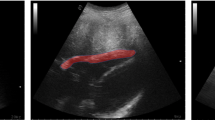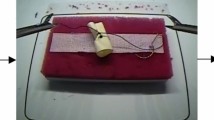Abstract
Ultrasound-guided needle insertion is a difficult skill to learn and, in the context of competency-based medical education, requires continual monitoring of trainees’ performance. This work investigates two standard neural network architectures, temporal convolutional networks and long short-term memory networks, for automated classification of skill level based on kinematics data. It examines which data representations are optimal for skills assessment using the proposed architectures in low data scenarios. The data representation had significant effect on the computed results. But given the optimal data representation, the proposed architectures achieve skills classification on two simulated ultrasound-guided needle insertion tasks with better performance than summary statistics. Thus, neural networks can be an effective tool for skills assessment in ultrasound-guided interventions; however, it is recommended to search over the space of data representations when limited data is available.
Access this chapter
Tax calculation will be finalised at checkout
Purchases are for personal use only
Similar content being viewed by others
References
Reiley, C.E., Lin, H.C., Yuh, D.D., Hager, G.D.: Review of methods for objective surgical skill evaluation. Surg. Endosc. 25, 356–366 (2011). https://doi.org/10.1007/s00464-010-1190-z
Holden, M.S.: Computer-Assisted Assessment and Feedback for Image-Guided Interventions Training (2019)
Hayter, M.A., et al.: Validation of the imperial college surgical assessment device (ICSAD) for labour epidural placement. Can. J. Anesth. 56, 419–426 (2009). https://doi.org/10.1007/s12630-009-9090-1
Corvetto, M.A., et al.: Validation of the imperial college surgical assessment device for spinal anesthesia. BMC Anesthesiol. 17 (2017). https://doi.org/10.1186/s12871-017-0422-3
Chin, K.J., Tse, C., Chan, V., Tan, J.S., Lupu, C.M., Hayter, M.: Hand motion analysis using the imperial college surgical assessment device: validation of a novel and objective performance measure in ultrasound-guided peripheral nerve blockade. Reg. Anesth. Pain Med. 36, 213–219 (2011). https://doi.org/10.1097/AAP.0b013e31820d4305
Clinkard, D., et al.: Assessment of lumbar puncture skill in experts and nonexperts using checklists and quantitative tracking of needle trajectories: implications for competency-based medical education. Teach. Learn. Med. 27, 51–56 (2015). https://doi.org/10.1080/10401334.2014.979184
Clinkard, D., et al.: The development and validation of hand motion analysis to evaluate competency in central line catheterization. Acad. Emerg. Med. 22, 212–218 (2015). https://doi.org/10.1111/acem.12590
Tabriz, D.M., Street, M., Pilgram, T.K., Duncan, J.R.: Objective assessment of operator performance during ultrasound-guided procedures. Int. J. Comput. Assist. Radiol. Surg. 6, 641–652 (2011). https://doi.org/10.1007/s11548-010-0541-5
Xia, S., et al.: A learning curve analysis of ultrasound-guided in-plane and out-of-plane vascular access training with Perk Tutor. In: Webster, R.J., Fei, B. (eds.) Medical Imaging 2018: Image-Guided Procedures, Robotic Interventions, and Modeling, p. 66. SPIE (2018). https://doi.org/10.1117/12.2293789
Vedula, S.S., Ishii, M., Hager, G.D.: Objective assessment of surgical technical skill and competency in the operating room. Annu. Rev. Biomed. Eng. 19, 301–325 (2017). https://doi.org/10.1146/annurev-bioeng-071516-044435
Wang, Z., M.F., A.: Deep learning with convolutional neural network for objective skill evaluation in robot-assisted surgery. Int. J. Comput. Assist. Radiol. Surg. 13(12), 1959–1970 (2018). https://doi.org/10.1007/s11548-018-1860-1
I.F., H., Forestier, G., Weber, J., Idoumghar, L., Muller, P.-A.: Accurate and interpretable evaluation of surgical skills from kinematic data using fully convolutional neural networks. Int. J. Comput. Assist. Radiol. Surg. 14(9), 1611–1617 (2019). https://doi.org/10.1007/s11548-019-02039-4
Castro, D., Pereira, D., Zanchettin, C., MacEdo, D., Bezerra, B.L.D.: Towards optimizing convolutional neural networks for robotic surgery skill evaluation. In: Proceedings of the International Joint Conference on Neural Networks (2019). https://doi.org/10.1109/IJCNN.2019.8852341
Kim, T.S., O’Brien, M., Zafar, S., Hager, G.D., Sikder, S., Vedula, S.S.: Objective assessment of intraoperative technical skill in capsulorhexis using videos of cataract surgery. Int. J. Comput. Assist. Radiol. Surg. 14(6), 1097–1105 (2019). https://doi.org/10.1007/s11548-019-01956-8
Oğul, B.B., Gilgien, M.F., Şahin, P.D.: Ranking robot-assisted surgery skills using kinematic sensors. In: Chatzigiannakis, I., De Ruyter, B., Mavrommati, I. (eds.) AmI 2019. LNCS, vol. 11912, pp. 330–336. Springer, Cham (2019). https://doi.org/10.1007/978-3-030-34255-5_24
Nguyen, X.A., Ljuhar, D., Pacilli, M., Nataraja, R.M., Chauhan, S.: Surgical skill levels: Classification and analysis using deep neural network model and motion signals. Comput. Methods Programs Biomed. (2019). https://doi.org/10.1016/j.cmpb.2019.05.008
Ahmidi, N., et al.: A dataset and benchmarks for segmentation and recognition of gestures in robotic surgery. IEEE Trans. Biomed. Eng. 64, 2025–2041 (2017). https://doi.org/10.1109/TBME.2016.2647680
Zhou, Y., Barnes, C., Lu, J., Yang, J., Li, H.: On the continuity of rotation representations in neural networks. In: Proceedings of the IEEE Computer Society Conference on Computer Vision and Pattern Recognition (2019). https://doi.org/10.1109/CVPR.2019.00589
Holden, M.S., Lia, H., Xia, S., Keri, Z., Ungi, T., Fichtinger, G.: Configurable overall skill assessment in ultrasound-guided needle insertion. In: 16th Annual Imaging Network Ontario Symposium (ImNO) (2018)
Acknowledgement
This research was enabled in part by support provided by Compute Ontario (www.computeontario.ca) and Compute Canada (www.computecanada.ca).
Author information
Authors and Affiliations
Corresponding author
Editor information
Editors and Affiliations
Rights and permissions
Copyright information
© 2020 Springer Nature Switzerland AG
About this paper
Cite this paper
Liu, R., Holden, M.S. (2020). Kinematics Data Representations for Skills Assessment in Ultrasound-Guided Needle Insertion. In: Hu, Y., et al. Medical Ultrasound, and Preterm, Perinatal and Paediatric Image Analysis. ASMUS PIPPI 2020 2020. Lecture Notes in Computer Science(), vol 12437. Springer, Cham. https://doi.org/10.1007/978-3-030-60334-2_19
Download citation
DOI: https://doi.org/10.1007/978-3-030-60334-2_19
Published:
Publisher Name: Springer, Cham
Print ISBN: 978-3-030-60333-5
Online ISBN: 978-3-030-60334-2
eBook Packages: Computer ScienceComputer Science (R0)





